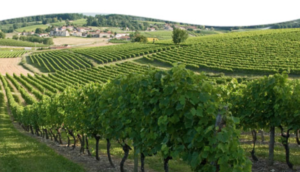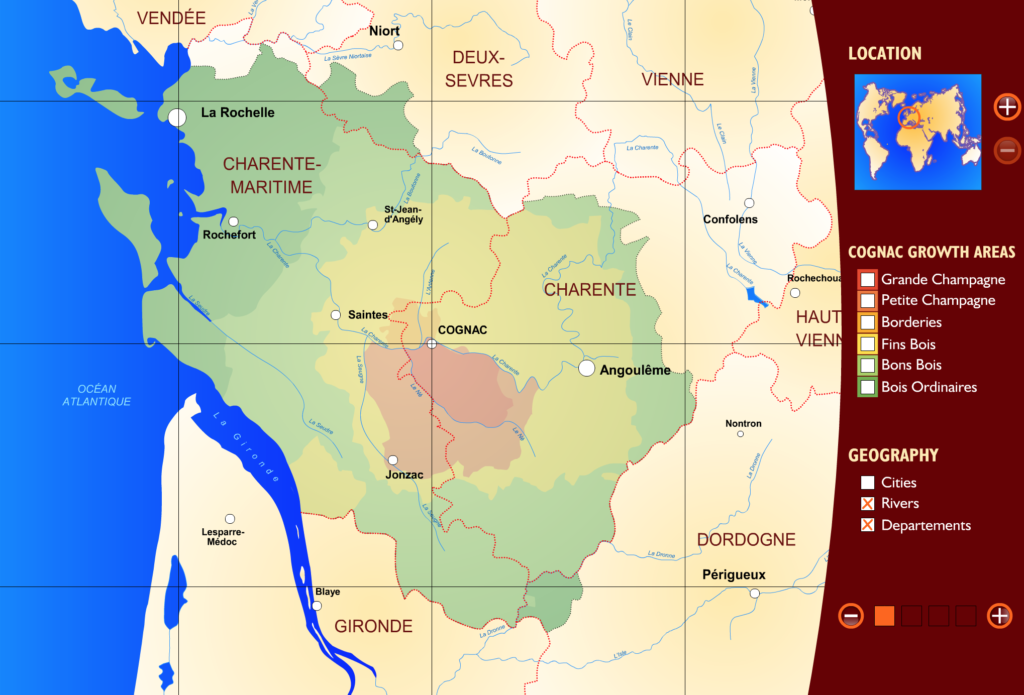Long gone is Cognac’s heyday of having over 280,000 hectares, but this 80,000 hectare wine region is renowned worldwide for its Brandy production. Here are the fast facts and quintessential terroir information on Cognac, including the climate, geography, Cognac process and production methods (including details on the fermentation, distillation, maturation in oak, addition of boise, and use of lees), grape varieties, history and taste profile of one of the most famous spirits in the world.
[mepr-hide if=”rule: 2080″]
…
This content is exclusive for Members. Take a look at the introductory packages below to become a Member of 80 Harvests and get unrestricted access to all our content.
Thank you for supporting the journey and being part of the 80 Harvests community!
[mepr-group-price-boxes group_id=”2070″]
[/mepr-hide]
[mepr-show if=”rule: 2080″]
Where is Cognac?
Tucked inland from La Rochelle and the Atlantic coastline, Cognac’s AOC covers the Charente-Maritime and most of the Charente departments, including some districts of the Dordogne and Deux-Sèvres.
Cognac is a place and refers to the final drink.
The Essentials of Terroir
Climate & Landscape
The Cognac region is formed of plains and small hills, and has a homogenously mild, maritime climate with some influence from the Charente river that runs through it.
Temperatures
The average temperature throughout the year is 13ºC and it experiences mild winters.
Rainfall
The average annual rainfall in Cognac is 850 mm per year. It rains quite consistently throughout the year with slightly heavier rainfall patterns in the winter.
Soils & Regions
The soils depend on the Cognac region:
The Champagnes: Cognac
Soft chalky soils with high limestone content (sometimes over 60%) dominate the Champagnes and offer good water reserves for the slightly drier summers. There is also some montmorillonite clay.
- The Grande Champagne Appellation: There are over 13,000 hectares of vines in the Grande Champagne and it is mainly used for white Cognac wines which become fine, light Cognac brandies with floral notes. These brandies benefit from long cask maturation.
- The Petite Champagne Appellation: It seems ironic this appellation is called Petite because it is, in fact, larger than Grande Champagne, with over 15,000 hectares planted. Perhaps the petite refers to its reputation because although it is similar to the Cognacs of Grande Champagne, they don’t produce as much finesse although equally benefit from a long maturity.
The Borderies: Cognac
With just under 4,000 hectares, this is the smallest Cru. The clay and flint soils produce slightly rounder Cognacs than the Champagnes, but are also quite fine with floral notes like violet and show finesse. These brandies generally don’t age as long as the Champagnes, they are ready to drink sooner.
The Bois: Cognac
If the Champagnes are the heartland of top quality Cognac production, the Bois are the bread and butter. These larger, wider areas surround the Champagnes and Borderies.
- The Fins Bois Appellation: Circling around the Champagnes and Borderies, this appellation covers 31,000 hectares and is mainly red clay-chalk soils which can sometimes be very heavy in clay. The smooth and round Cognac brandies from here age quite quickly and show mainly fruity aromas.
- The Bons Bois Appellation: Forming an even bigger circle around the Fins Bois, the Bons Bois is wider spread but has just over 9,000 hectares planted under vine. The soil is a really mixed bag because of the much wider territory and you get sandier soils close to the coast and in the south close to the Gironde river, as well as clay-limestone further inland and north, and many different forests inbetween. The Cognac wines are fruity and age fast.
- The Bois à Terroir or Bois Ordinaires: With only a small pocket of vineyards to the far south-east, the majority of the 1,000 hectares of the Bois Ordinaires is on the coast and is dominated by sandy soils. The wines are fresher because of the maritime influence but the brandies age very quickly.
Longitude
0.32˚W
Latitude
45.7˚ N
Viticulture Facts & Vineyard Management
79,636 hectares planted with vines, spread over a region of over a million hectares.
 Yields, training and vineyards
Yields, training and vineyards
Cognac vines are approximately 1-1.5 meters tall cultivated in wide rows (3 meters apart) which are suitable for machine harvesting. The yield is high.
Grape Varieties
For Cognac production, there are 9 grape varieties are permitted: Ugni Blanc, Colombard, Folle Blanche, Jurançon blanc, Meslier Saint-François, Montils, Sémillon, Folignan and Sélect. However to be considered Cognac it must include a minimum of 90% of Ugni Blanc, Folle Blanche and Colombard (as a blend of single variety). In reality, most Cognacs are made from Ugni Blanc alone.
The wines
All of the above leads you to the conclusion that while Cognac might be a pleasant place to live, the wines are rather boring. Couple that with the fact that 90% of the vines planted are Ugni Blanc, and I’m not surprised if you are yawning. The good news is that 95% of Cognac’s production is distilled and turned into a far more characterful drink – brandy.
And while Ugni Blanc makes an unremarkable wine (high acid, medium alcohol, a short finish and very little aroma), it makes a neutral base for distillation in the Cognac process. What’s important for Cognac production is its high acidity (even when harvested late), its resistance to grey rot and its high yields.
Cognac process: Winemaking, distillation and maturation
The grapes are often machine harvested and pressed immediately using basket plate presses or pneumatic bladder presses. The must is fermented in less than 2-3 weeks (no capitalisation/additional sugar is permitted) and results in a 7-8% AVB wine.
The convert the wine into brandy the cognac process begins with distillation in traditional Charentais copper stills with maximum 30hl capacity, as regulated by law.
The Cognac process has two distillations:
- “brouillis” (first distillation) which reaches 28-32% vol
- “repasse” (second distillation) which reaches a maximum of 72% abv
Distillation must be completed by March 31st following the harvest by law.
The Cognac must be aged in oak casks for a minimum of 2 years.
The Cognac has to be sold a minimum of 40% abv and can be reduced (from its 72% abv distillation) using distilled or demineralised water. A boise (sugar, caramel, oak infusion) can be added to adjust the final colour and taste.
Fine Champagne Appellation Brandy (AOC)
- Must come from a blend of Grande and Petite Champagne, with a minimum of 50% coming from Grande Champagne.
[/mepr-show]


